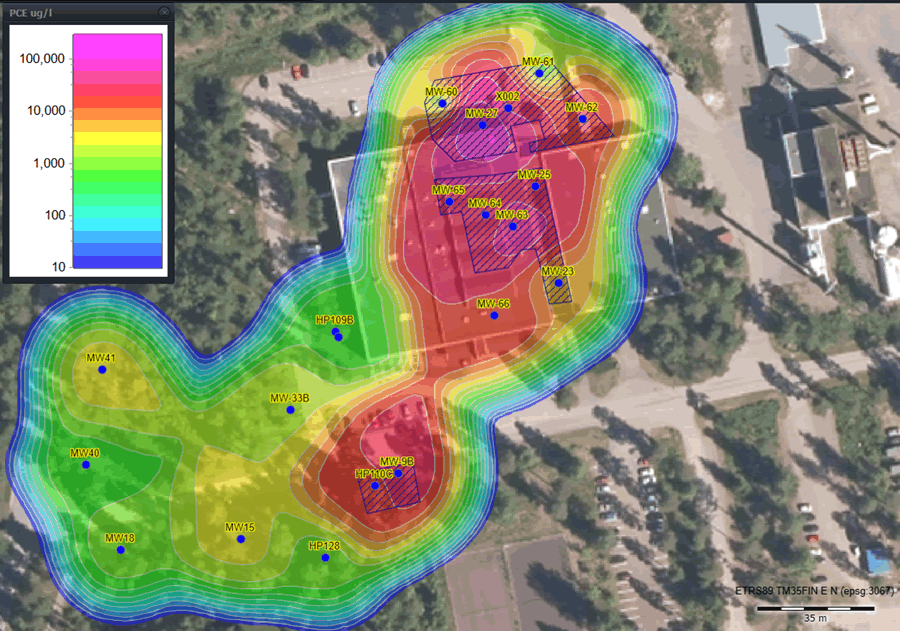ABSTRACT
The subject site is a former dry cleaning facility in Northern Europe, where a large tetrachloroethylene (PCE) plume was impacting groundwater on and off-site. In 2017, CAT 100 and BOS 100® were applied as part of a large-scale remediation program. Currently, a 95% average reduction in PCE concentrations has been observed in the monitoring wells located in the areas targeted by the remediation.


CAT 100 and BOS 100® Application at Northern European Active Industrial Site
A large PCE plume associated with a former dry cleaning facility in Northern Europe was treated with CAT 100 and BOS 100® as part of a large-scale remediation program.
PROJECT SNAPSHOT
Key Dates
• Remedial Design Characterization (RDC) – Spring 2016
• Injection of BOS 100® and CAT 100 – Spring 2017
Monitoring Period: 1,305 days
Treatment Area: (Figure 1) 23,680 ft2 (2,200 m2)
Lithology: Fine to coarse sand underlain by glacial till; boulder clay is present throughout most of the site.
Depth to Water Table: 10-13 ft (15 m) below ground surface (bgs)
Contaminants: Chlorinated ethenes (DNAPL in Source)
Implementation Method: Direct push injection
APPROACH
• An RDC was performed across an area of approximately 15 to 17 acres (60-70,000 m2), including the entire site and part of the off-site downgradient area. The RDC included 45 Membrane Interface Probe (MIP) points, 21 soil core locations and 13 newly installed monitoring wells. A total of 255 soil samples and 38 groundwater samples were collected and submitted to the RPI Project Support Laboratory for pro bono analyses.
• Based upon the RDC results, the remedy included the following: 105,822 lbs (~50,000 kg) of CAT 100 and 8,378 lbs (~3,800 kg) of BOS 100® applied into 702 injection locations at depths varying from 10 to 20 ft bgs (3 to 6 m bgs), and 23 to 39 ft bgs (7 to 12 m bgs)
Figure 2. Figure 2. Well MW-9B, BOS 100 Treatment Area, Downgradient of CAT 100 Source Treatment
Figure 3. Well MW-63, CAT 100 Source Area Treatment
CHALLENGES & OBJECTIVES
The challenges for this project included the presence of a large area of DNAPL within a complex hydrogeological setting that consists of a perched, unconfined aquifer overlaying a semi-confined aquifer, and performing injections inside a building basement with less than 7 ft (2.1 m) of clearance. The primary objective was to design a multi-year remedy that was affordable and effective while delivering a significant reduction in PCE concentrations at the site boundary from levels of >10,000 μg/l to 10 μg/l. To accomplish this objective, BOS 100® was selected for portions of the site where less contamination was present and CAT 100 was selected for areas containing DNAPL (measured or suspected).
RESULTS
Currently, a 95% average reduction in PCE concentrations has been observed in the twelve monitoring wells located in the areas targeted by the remediation. In addition, DNAPL measured in the source area wells has been significantly reduced or eliminated. Biological degradation (e.g. generation of daughter products, volatile fatty acids and ethylene) and abiotic treatment (e.g. acetylene) parameters are providing clear evidence that treatment is on-going and will continue. Eighteen months after injections were completed, microbial diagnostic analyses were performed on samples from four wells within the treatment area. Dehalococcoides ethenogenes (DHC) and key functional genes were detected at elevated concentrations in three of the four wells. The sample that did not detect DHC came from a well where DNAPL had been measured historically.
NEXT STEPS
Regular groundwater monitoring is planned to continue until 2022 or until obtaining a No-Further Action letter.
Figure 1. Site Map with Injection Areas (Note: downgradient Area E, well MW-9B, not shown)









